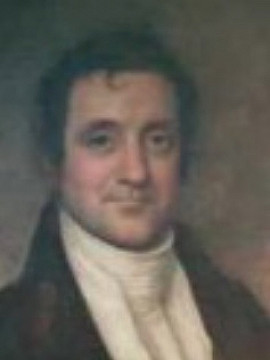Joseph Curtis (1782-1856)
Joseph Curtis, of New York City
He was born at Newtown, Connecticut, and came to New York City at the age of sixteen. He became a partner in Willmarth, Moffat & Curtis, successful manufacturers of jewellery and pencil cases, in partnership with his entrepreneurial brother-in-law, John L. Moffat. But, Curtis' name is not remembered for business, his real energies were directed towards bringing an end to slavery and providing free education to all. In 1804, he stood by Governor DeWitt Clinton at the opening of the first free school in the United States, "and that one, it may be remarked, an African one". In 1817, he was an active member of "The Manumission Society" (along with Peter Augustus Jay and Cadwalader Colden etc.) and in recognition of his work towards securing passage of the Gradual Emancipation Act, he received two "massive silver pitchers" as a token of their appreciation. He was active in establishing the Society for the Prevention of Vagrancy and was "the leading spirit" behind the New York House of Refuge. In 1820, at Flatbush, L.I., he established the first Sunday School ever instituted for Free Blacks.
He was a co-founder and Trustee of the Public School Society for 33-years and in 1853 he was chosen as one of the fifteen Commissioners to represent the Society at the Board of Education. As a young man he had served as a fireman for twenty years, and was the first to introduce the firemen's torch. He was also the first to establish "hose-carriages" in New York; and, first proposed and secured the use of ventilators for the sewers. He was married in 1804 and had six children, of whom four survived to adulthood. His son made a fortune and built Drayton House in Hyde Park. His son tried to share his wealth with him, but Joseph required no more money and was content to live in the same house that he had lived in since his marriage in 1804, 92 Maiden Lane, where he died.
He was a co-founder and Trustee of the Public School Society for 33-years and in 1853 he was chosen as one of the fifteen Commissioners to represent the Society at the Board of Education. As a young man he had served as a fireman for twenty years, and was the first to introduce the firemen's torch. He was also the first to establish "hose-carriages" in New York; and, first proposed and secured the use of ventilators for the sewers. He was married in 1804 and had six children, of whom four survived to adulthood. His son made a fortune and built Drayton House in Hyde Park. His son tried to share his wealth with him, but Joseph required no more money and was content to live in the same house that he had lived in since his marriage in 1804, 92 Maiden Lane, where he died.
Parents (2)
Categories
Share
Biography of Joseph Curtis, A Model Man (1858), by Catharine Maria Sedgwick; Joseph Curtis and the NY Manumission Act of 1817, by Jeff Detoro for the Jay Heritage Center; Family Search, Curtis Genealogy;



